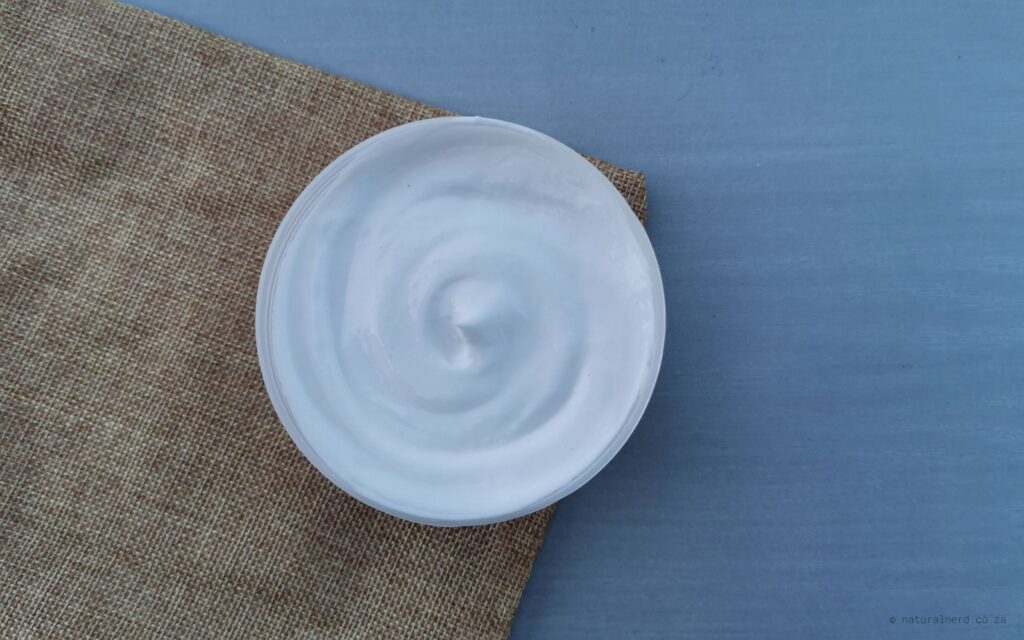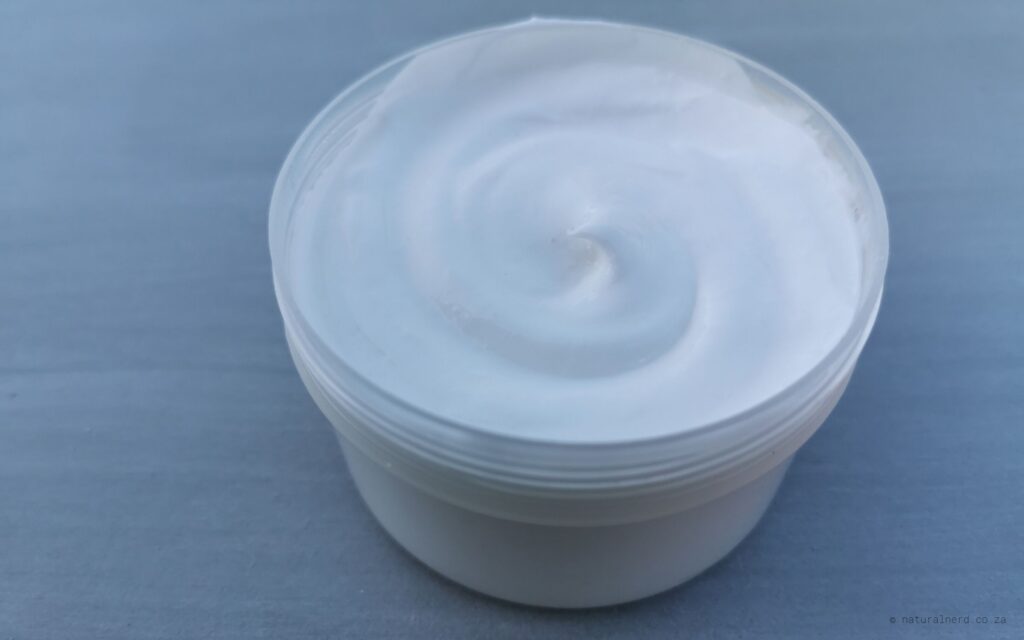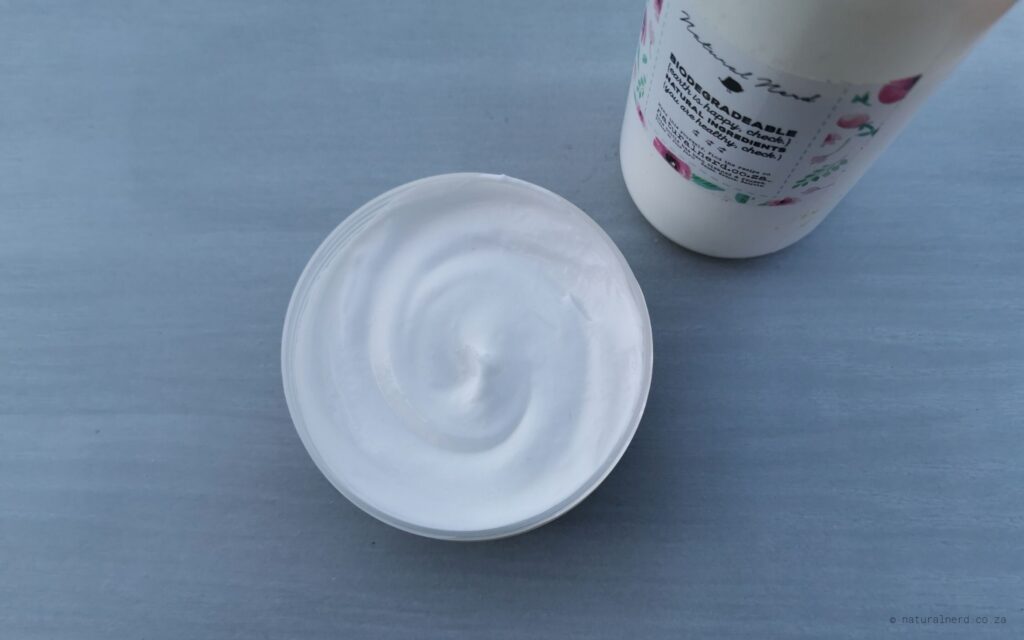Traditionally, aqueous cream is very light, well absorbed and fragrance-free. This light cream is achieved by using – as the name aqueous suggests – mostly water. Many people prefer to use aqueous creams for their sensitive skin, eczema or for their children’s skin. Therefore, the key to achieving a good aqueous cream is to formulate an oil-in-water emulsion which uses hypoallergenic carrier oils.
Having said that, don’t expect this cream to be richly nourishing. If that is what you’re looking for, rather make my rich winter body cream recipe instead. This recipe will definitely moisturise your skin, but it’s so light that it won’t feel greasy and rich like most creams and body butters. If you have never made a cream emulsion before, please refer to my basic lotion recipe for step-by-step photos.

Natural Aqueous Cream
Ingredients
Water Phase:
- 150g Deionised / Distilled Water
- 6g Vegetable Glycerine
- 1g Xanthan Gum (about 1/8 teaspoon)
Oil Phase:
- 20g Grapeseed Oil
- 6g Castor Oil
- 14g Eco E-wax
Cool Down Phase:
- 1g Citric Acid 25% Dilution (approx. 1ml)
- 1g Geogard 221 OR Euxyl K903 (preservative)
- 1g Natural Vitamin E Oil
- Essential oils (optional)
Equipment & Tools:
- Kitchen Scale (to weigh all ingredients)
- Blender or Whisk
- Graduated Pipette or Syringe (to measure small volumes)
- 2x Heat-proof pots or beakers
- 2x Stainless steel spoons
- 2x Hot Plates / Stoves
- pH strips or digital pH meter (optional)
- Thermometer (optional)
- Sterilized container (to store cream)
Instructions
- Makes 200g. This recipe must be followed in weight (grams).
- Prepare your station: First disinfect your working surface, equipment and packaging with min. 75% rubbing alcohol or bleach and allow to air dry. This is important for preventing contamination of your product.
- Prepare the oil phase: Place all oil phase ingredients into one pot. Don’t forget the Eco E-wax!
- Prepare the water phase: Place the distilled water into another pot.
- In a separate saucer or tot glass, combine the vegetable glycerine with xanthan gum. Set aside for later.
- Heat both phases: Start to heat the contents of both pots at exactly the same time, on the lowest heat setting. If you can heat both phases over a double-boiler, that is ideal, but it will still work with direct heat. A double-boiler is just a gentler heating method.
- Add glycerine slurry to warm water: When the water becomes warm (~30’C), add the glycerine-xanthan mixture to the water phase and mix well. The water will become murky and thicker, like a gel.
- Continue heating both phases: Do not allow the ingredients in either pot to boil or get above 70’C. The contents should get hot, but not boiling hot. If you can’t get both pots to the same temperature, rather have the water phase hotter.
- Combine both phases: Once the contents of both pots are the same hot temperature (approx. 70’C), combine them by adding the water phase to the oil phase.
- Blend until trace: Whisk manually for about 15 minutes or blend for 20-30 seconds, until you see that the oil has combined with the water and the mixture is uniformly white and creamy. You can stop blending when you reach trace – this is when your stirring movements are visible, because the product is thick enough that it leaves a trace on the surface like footprints. This is your cream.
- Prepare the cool down phase: Set your cream aside to cool down to room temperature (min. 40’C). Don’t cover with a lid.
- Correct pH: Once cooled, stir in the diluted citric acid (1ml of a 25% dilution).
- Preserve: Add the Geogard 221/ Euxyl K903 preservative when the cream has cooled completely. Ensure that you mix this in very well, so that the preservative is evenly distributed.
- Stir in the Vitamin E oil (and essential oils, if using). Maximum essential oil dosage: 20 drops per 200g.
- Transfer your lotion into a sterilised container using a funnel if necessary, and store away from direct sunlight. Use within 3 months.
Notes
- The preservative is necessary, since there is water in this recipe. Water invites microbial growth. Without the preservative, this lotion will have a maximum shelf life of one day, even if it’s kept in the refrigerator. Without a preservative; dangerous bacteria, fungus, mould and yeast will start to grow.
- You may use any preservative, but bear in mind that each preservative has different applications and usage rates. So make sure to read the manufacturer’s directions and adjust the recipe accordingly. If you use a different preservative, your pH will be different to my recipe, therefore you will have to test & correct the pH yourself.
- When I make this recipe, the pH tests at 8 after it’s cooled down, which is too high, so I correct it by adding citric acid. The ideal pH should be between pH 5 – 5.5. To make this solution, dissolve 1 part citric acid in 4 parts distilled water (in weight). In other words, 1 gram citric acid dissolved in 4 grams distilled water. Mix a few drops at a time into your cream, retest and repeat until you get the correct pH. If the pH is too low, do the same with a 50% bicarbonate of soda solution or a 25% sodium hydroxide solution to bring the pH upwards.
- Essential oils that are generally safe for children: lavender, chamomile, tea tree. Don’t add more than 10 drops if you will be using this cream for young children.
- Essential oils for dry skin: lavender is best. Other options include rose, geranium, chamomile, sandalwood, frankincense.

Recipe variations
Changing quantities:
If you want to make a bigger batch, you may multiply the quantities. For example, multiply all ingredients by 5 to make one kilogram of lotion.
Xanthan gum substitutes:
You can use guar gum instead of xanthan gum in this recipe.
Vegetable glycerine substitutes:
You can use any glycerine in this recipe. I just prefer using vegetable glycerine, because it is sourced from plants. Some glycerine is sourced from animals.
Natural vitamin E oil:
You can use the contents of Vitamin E capsules, which typically contains vitamin E acetate. However, this form of vitamin E will only provide benefits to your skin, but it won’t prevent the oxidation of your carrier oils. Only natural vitamin E oil, also known as d-alpha tocopherol will prevent oxidation.
Distilled water substitutes:
You can use deionised water or a hydrosol as a substitute for the distilled water in this recipe. You cannot use tap, filtered, spring or bottled water when making cosmetics, as these types of waters are not pure enough and may contaminate your cream. If you’d prefer not to use essential oils, but you want a fragrance, then I highly recommend using a hydrosol instead. Hydrosols are like flavoured distilled waters that are significantly milder, safer and cheaper than essential oils. Rose water is an example of a hydrosol.
Oil substitutes:
You may substitute the oils in this recipe with any other oils as long as you use the exact same weight. I recommend using a liquid oil, and one that is hypoallergenic like hemp, sunflower, sweet almond, apricot kernel, canola or jojoba oil. Generally when you substitute oils in formulas, you want to match the viscosity and melting point, so that you can achieve a similar texture. Avoid using sweet almond and apricot kernel oil if you have a nut allergy though. If you do substitute, I cannot guarantee that it will have the same texture, colour or scent as my recipe, since each oil brings different properties to lotions.
Adding essential oils:
After your cream is completed, you may stir in up to 4ml of additives like essential oils, glycerine and vitamin E oil. Lavender essential oil is a good choice for sensitive skin, and is considered a safe essential oil for children. I recommend using a maximum of 1ml (~20 drops) of essential oils.
Citric acid:
You may choose to exclude the citric acid solution if your cream tests to at least a pH6. However, if it tests to pH8, like mine did, you must lower the pH in order for the preservative to work. Geogard 221 and Euxyl K903 are only effective within pH 2-6 range. So, at pH8 you will have an unpreserved product. Citric acid is strongly recommended also because it lowers the pH of this lotion from pH8 (neutral) to pH5.5 (slightly acidic), which is the natural pH of our skin. You may also use your own pH strips / meter to measure the pH of your lotion, and add a few drops of citric acid at a time until you reach a pH5.5. If you adhere to my exact recipe (without substitutes), you should require approximately 1ml of a 25% citric acid dilution to achieve this desired pH. To make a 25% dilution, dissolve 1 part of citric acid in 4 parts of distilled water (in weight).
Preservative substitutes:
When I make this recipe, I use the preservative Geogard 221 (which is dehydroacetic acid diluted in benzyl alcohol). Euxyl K903 is the best substitute, because it’s basically identical to Geogard 221 except that it also contains Vitamin E. The manufacturer’s instructions are identical.
Geogard 221 is a golden liquid, whereas Geogard Ultra (used in my other recipes) is a powder. The names are similar, so don’t get confused.
You may use any cosmetic preservative you wish, but I recommend looking for broad spectrum preservatives that are permitted in certified organic products like Geogard 221, Geogard Ultra and Euxyl K903.
Remember that each preservative has its own directions for use, so simply adjust the instructions in this post about when to add the preservative and how much of it to use according to the manufacturers instructions.
To illustrate how a different preservative can change a recipe, let’s use Geogard Ultra as an example. If you use Geogard Ultra powder instead, this is what changes:
- Usage rate: You’ll need to use more Geogard Ultra in this recipe, because it’s recommended usage rate is 1%. Therefore you’ll need 2g of Geogard Ultra in this recipe for a preserved product.
- pH adjuster: Geogard Ultra will cause the pH of your product to test too low, which means that you’ll need to add an alkaline solution like sodium bicarbonate or sodium hydroxide to bring the pH upwards, instead of the citric acid solution.
- Solubility: Since Geogard Ultra is a powder, it will take longer to dissolve when you add it in step 13, despite it being water-soluble. Therefore, you should probably give the product a good blend again right at the end and check to make sure that there are no undissolved, powdery grains.
- Temperature: Geogard Ultra is not as heat sensitive as Geogard 221. Due to this, you can technically add an alkaline pH adjuster into the hot water phase in step 7, then followed by Geogard Ultra powder.
- Effective pH range: Geogard Ultra is effective within pH 3-6, whereas Geogard 221 is effective within pH 2-7. A small, but important difference to ensure that your product is within the safe range.
See how much can change when you change the preservative! Please consider all these factors when substituting preservatives.

Cost & Shelf Life
Cost Price: R 18.90 per 200g excluding essential oils (at the time of writing in 2020).
Lasted me about: 1 month using twice a day for my face and hands.
Estimated shelf life: 3 months if you include the preservative, use sterilised equipment and store away from direct sunlight. Without the preservative, this lotion only has a shelf life of 1 day when stored in the refrigerator. Please note that ingredients like vitamin E oil and anti-bacterial essential oils will not effectively preserve your product.
Challenge
Preservatives: Some people may be weary about including a synthetic preservative. However, all preservatives are synthetic. They have to be, in order to kill microbes. If you use any emulsion product, even organic creams, they all contain synthetic preservatives. But some preservatives are worse than others. Therefore, all preservatives used in my recipes are ECOCERT and SOIL Association approved to be used in certified organic products, and have no evidence of being toxic when used as instructed by the manufacturer. If you’d still prefer to avoid preservatives, please browse my preservative-free recipes instead.
Cherry on top
- No Petroleum and Paraffin (also known as mineral oil). Yes, that’s what is inside popular aqueous creams.
- Achieve moisturised skin, without the oily residue.
- Ideal for sensitive skin and eczema.
- The texture is just like the aqueous cream you buy in-store, except it’s completely natural.
- Works out cheaper than buying natural aqueous cream brands, and is about the same price as ordinary retail brands.
Ingredients
- Deionised / Distilled water: is a pure form of water without additional minerals, salts and other deposits which typically shorten the shelf life of a lotion. You can find distilled water at most pharmacies. Don’t confuse distilled water with filtered, spring or purified water – they are not the same thing. (Buy here)
- Vegetable glycerine: moisturises the skin and retains moisture in the skin by acting as a protective barrier that locks in moisture. It is also necessary to hydrate the xanthan gum in the recipe to prevent clumps from forming. (Buy here )
- Xanthan gum: stabalizes the lotion so that it does not separate or curdle in heat. Xanthan gum is a sugar derived from either corn, soy or wheat. (Buy here)
- Castor oil: is a hypoallergenic oil with a low comedogenic score, making it ideal for sensitive skin. It is rich in fatty acids, especially high in ricinoleic acid. It is used to treat dry, irritated skin and wrinkles, and is also reputed to boost collagen production. If you are pregnant, please speak to your doctor before using castor oil topically. (Buy here)
- Grapeseed oil: is a hypoallergenic oil with a low comedogenic score, making it suitable for all skin types. It is one of the lightest and best absorbed carrier oils, and it lacks fragrance. Grapeseed oil contains vitamin E, and has been shown to improve skin tone, and help the vitamin C and E in your skin to be more efficient. (Buy here)
- Eco E-wax: is a vegetable-based emulsifying wax which allows water and oil to combine without separating. It is also known as Glycerol Monostearate SE, and is ECOCERT and SOIL association approved for use in natural and organic products. (Buy here)
- Geogard 221 / Euxyl K903: are synthetic preservatives composed of benzyl alcohol and dehydroacetic acid as an amber liquid. It is ECOCERT, NATRUE and SOIL association approved for use in natural and organic products. (Buy here)
- Natural Vitamin E oil: An antioxidant that protects the skin from further sun damage, treats damaged skin, and it helps decrease the signs of lines and wrinkles. In this recipe natural vitamin E oil also protects the oils from oxidation, thereby improving shelf life. (Buy here)
- Citric acid: is an organic acid that occurs naturally in citrus fruits and is a common additive in foods. In this recipe, citric acid is used to lower the pH of the neutral lotion to the natural pH of human skin, which is slightly acidic at pH 5.5. (Buy here)
Need help finding these, or other ingredients? My shopping guide may help you.
Recommended retail option
If you don’t want to make it yourself, then Oh-Lief Natural Aqueous Cream is a really good product that I recommend. I have bought and used this product myself. It contains simple ingredients, and is also fragrance-free. This product also has the best reviews on Faithful to Nature for aqueous creams. It is, however, more pricey than making it yourself. It also contains the same emulsifier and preservative as my recipe.
Do you think that this is an effective aqueous cream for sensitive skin? If you’ve tried it, please share your feedback in the comments below.


Hi, I made this lotion and it turned out great, my only issue is that when I first apply it on my hands it looks stringy what could be causing this?
Hello Martha, and thank you for your feedback. It’s hard for me to know exactly what “stringy” looks like without seeing the cream. When I experience “stringy” cream I understand that to mean when too much xanthan gum has been added and it has a thick and almost sticky texture. If the cream is on your fingers, and you separate them, it stretches out like elastic. Is that what your cream looks like? If so, then it’s too much xanthan gum. If not, you can send me a message on one of my social media channels, and attach a photo or video of the cream. That way, I may be of more help to you.
Hi Christina,
I made this lotion in the past and loved it. I ran out and made more tonight, but I screwed up and it’s very watery 😩. I know where I screwed up..but is there anything I can do to fix this?
Hello Erin. Perhaps if you tell me what you did wrong, then I can help determine if there is a fix for it. What went wrong? Did you forget the xanthan gum?